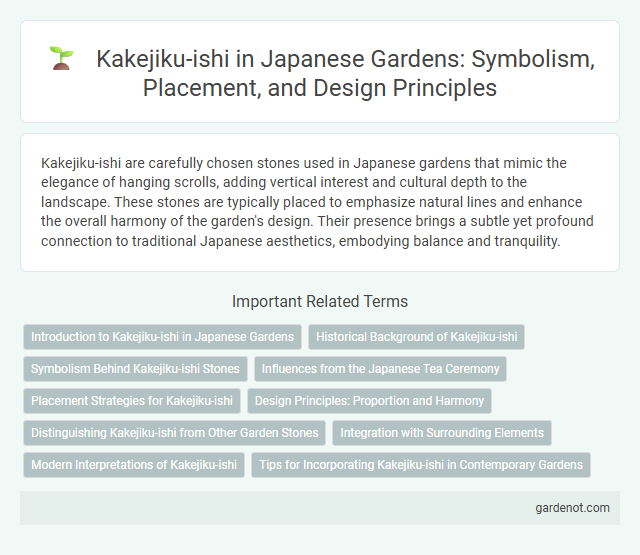Kakejiku-ishi are carefully chosen stones used in Japanese gardens that mimic the elegance of hanging scrolls, adding vertical interest and cultural depth to the landscape. These stones are typically placed to emphasize natural lines and enhance the overall harmony of the garden's design. Their presence brings a subtle yet profound connection to traditional Japanese aesthetics, embodying balance and tranquility.
Introduction to Kakejiku-ishi in Japanese Gardens
Kakejiku-ishi, or hanging scroll stones, are integral elements in Japanese garden design, symbolizing natural landscapes within a compact space. These stones are carefully selected for their unique shape and texture, often resembling mountains or cliffs, and are strategically placed to enhance the garden's aesthetic harmony. Their placement follows traditional principles of balance and asymmetry, creating a contemplative atmosphere that reflects Japanese cultural values.
Historical Background of Kakejiku-ishi
Kakejiku-ishi, traditional Japanese garden stones, have roots dating back to the Heian period (794-1185), where they symbolized natural landscapes and spiritual elements. These stones were meticulously selected and arranged to enhance the garden's aesthetic and convey Zen Buddhist principles. Historically, Kakejiku-ishi played a crucial role in tea ceremonies, reflecting the harmonious relationship between nature and human artistry.
Symbolism Behind Kakejiku-ishi Stones
Kakejiku-ishi stones in Japanese gardens symbolize harmony and the transient beauty of nature, reflecting Zen Buddhist principles of impermanence and mindfulness. These carefully placed stones evoke a sense of balance and serenity, encouraging contemplation and spiritual connection within the garden space. Their subtle arrangement often represents mountains or islands, enhancing the garden's metaphorical landscape and deepening its symbolic meaning.
Influences from the Japanese Tea Ceremony
Kakejiku-ishi, the hanging scroll stone, plays a significant role in Japanese gardens by reflecting principles derived from the Japanese tea ceremony, emphasizing simplicity, tranquility, and seasonal awareness. The stone's placement and selection harmonize with the tea room's aesthetic, enhancing the meditative atmosphere essential to the tea ceremony. This intersection of garden design and tea culture illustrates the deep influence of wabi-sabi and mindfulness in traditional Japanese landscaping.
Placement Strategies for Kakejiku-ishi
Kakejiku-ishi placement in Japanese gardens emphasizes harmony with surrounding elements like water features, pathways, and other stones to enhance natural flow and aesthetic balance. Strategic positioning considers sightlines from multiple angles, ensuring the stone serves as a focal point or subtle accent that guides viewer movement. Proper placement also reflects principles of wabi-sabi, valuing simplicity and asymmetry to create a serene and contemplative atmosphere.
Design Principles: Proportion and Harmony
Kakejiku-ishi stones in Japanese gardens exemplify meticulous design principles emphasizing proportion and harmony, carefully sized to complement surrounding elements without overwhelming the natural landscape. Their placement follows traditional aesthetics, ensuring balanced spatial relationships that enhance tranquility and visual flow. By harmonizing scale and context, kakejiku-ishi contribute to the garden's serene atmosphere and timeless elegance.
Distinguishing Kakejiku-ishi from Other Garden Stones
Kakejiku-ishi in Japanese gardens are characterized by their vertical, scroll-like appearance reminiscent of hanging scrolls (kakejiku), setting them apart from the more horizontally oriented stepping stones and boulder formations. These stones often serve as focal points, emphasizing height and elegance within the garden's composition, contrasting with flat or round stones used primarily for pathways or grounding elements. The intentional placement and unique shape of Kakejiku-ishi contribute to the garden's dynamic visual narrative, blending natural beauty with cultural symbolism.
Integration with Surrounding Elements
Kakejiku-ishi stones in Japanese gardens are carefully positioned to harmonize with surrounding elements such as moss, water features, and plantings, creating a balanced and natural appearance. Their placement often follows the principles of wabi-sabi, emphasizing simplicity and asymmetry to blend seamlessly with the environment. These stones act as focal points while enhancing the overall composition, guiding the viewer's eye through the garden landscape.
Modern Interpretations of Kakejiku-ishi
Modern interpretations of Kakejiku-ishi blend traditional Japanese garden aesthetics with contemporary design principles, enhancing the visual flow and harmony of outdoor spaces. These stone scrolls serve as dynamic focal points, often integrated with minimalist landscaping and natural materials to complement urban and residential settings. Innovative use of lighting and placement emphasizes their symbolic role in connecting nature and art within modern Japanese gardens.
Tips for Incorporating Kakejiku-ishi in Contemporary Gardens
Incorporate Kakejiku-ishi into contemporary gardens by selecting stones with natural textures and asymmetrical shapes that evoke traditional Japanese aesthetics. Pair these stones with minimalist plantings and clean lines to create a harmonious balance between natural elements and modern design. Position Kakejiku-ishi near pathways or water features to enhance focal points and encourage mindful contemplation.
Kakejiku-ishi Infographic

 gardenot.com
gardenot.com